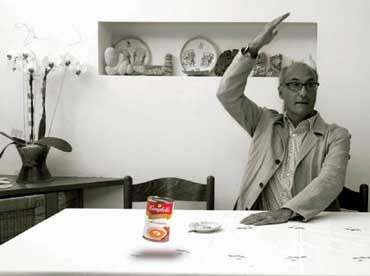Barcelona arts centre plan sparks national protest
Catalan government criticised for alleged heavy-handed manoeuvring
Matt Elmore | 7.1.09 | Issue 198
 Email writer
Email writer
 Print
Print
 Comment
Comment
![]() Send
article
Send
article

New director Vincenç Altaió portrayed by artist Albert Heras
BARCELONA. The controversy over the future direction of Barcelona’s Centre d’Art Santa Monica is about to enter a new phase with the release of its 2009 programme, which has been shown exclusively to The Art Newspaper. The programme is a radical departure from the original concept of the Santa Monica space as a visual arts centre devoted to Catalan artists, and follows six months of overwhelming opposition to the proposed changes. Until July, when a new director was appointed, the centre mostly showed artists based in Barcelona—leading some to allege it was operating for the benefit of a clique, while others considered it an essential means of support and dissemination for local work.
The
programme, under new director Vincenç Altaió, focuses on film, science,
technology, communication, history and architecture. The programme
includes a photography exhibition documenting environmental changes in
Antarctica while “From A to X” will feature performances by 12 of
Europe’s most famous actresses. Mr Altaió is a poet, essayist and art
critic who has previously organised exhibitions for the Joan Miró
Foundation in Barcelona. For nearly 15 years he has been the director
of the KRTU (Culture, Research, Technology, Universals) organisation,
which publishes books and holds seminars. Mr Altaió’s post was created
by merging the funds for KRTU and the Santa Monica Centre, creating a
budget of €1.6m, which is expected to increase sharply when a federal
funding agreement is signed with Madrid.
His vision, which
will be formally announced at a press conference later this month, will
confirm that the Santa Monica arts centre will no longer be a
traditional visual arts centre. As Mr Altaió described it: “It will be
cutting edge. I’m convinced of that. When I’ve spoken to editors,
directors, artists, from here and elsewhere, the general perception is
very positive.”
But Pilar Parcerisas, author and president of
the Asociación Catalana de Críticos de Arte (the association of Catalan
art critics), told The Art Newspaper: “This is a [complete
change] of plan. This project is about science and communication,
dance, theatre—it’s a cultural centre. It’s not an art centre, not as
we understand art centres in Europe.”
Ms Parcerisas also
criticised the way the change of direction had been implemented. The
Catalan government’s Council of Culture named Mr Altaió director in
July without advertising the post, nor advising the then current
director, Ferran Barenblit, who stepped down the following day. In
response, the Catalan critics association, the Catalan Visual Arts
Association, the Independent Gallery Owners of Catalunya and a number
of other organisations, joined together to condemn the council’s plan
to eliminate Barcelona’s last remaining government-sponsored venue for
local artists. Criticism was voiced across Spain, including from
Madrid’s Reina Sofía Museum, whose director, Manuel Borja-Villel,
denounced the council’s methods in the newspaper El Pais.
“The
Council of Culture’s proposal smacks of deception and implies bad
planning and erratic politics, not to mention the ugliness of naming a
director while there is still another in charge. This is a process that
is sloppy and dangerous,” he wrote.
However, Dani Hernandez, representing the council, told The Art Newspaper that the previous administration did not invite open applications before making Mr Barenblit director.
|
HOME | CURRENT ISSUE | ARCHIVE | WHAT'S ON | NEWSLETTER | SUBSCRIBE | FAIR EDITIONS | CONTACT | JOBS | PRIVACY |
©2009 The Art Newspaper |


